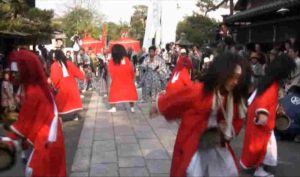Occurrence of Furyu
Furyu” became a central element of the popular arts throughout the Middle Ages.
Aesthetics of flamboyance and surprising taste
Early records of “Yasuraibana” (late Heian period)

Yasuraibana performed at Imamiya Shrine
Ryojin Hisho Kuden Shu, Vol. 14
Description of hanagasa (hana-gasa) and uta-bue taiko (flute and drum)
In 1151, around the time of March, men and women from the Kyoto area went to the Murasaki Shrine to play a furyu no asobi, calling it a kami asobi, and gathered in a crowd to sing and dance, not in the traditional manner, not in the sounds of a random dance, nor in the beat of a quick song. The sound is unmistakable.
They put a flower of the furyu on their umbrellas, dress a child in a hanjiri (a kimono with a woven pattern) like a straw hat, put a katsuko on their chest, and dozens of people imitated the Ranbu dance in unison with the beat of the Doubutsu. The bride wore a mask with a red and red headdress around her neck in the shape of an ogre, and wore a mask with a red and red headdress around her neck in the shape of a fish mouth.
The entire city of Kyoto was covered in kimono and shades for women, and even the nobility of Kyoto came to visit and enjoy the festivities. At night, the pine trees were lit up and everyone came to play. The priests and court nobles came to enjoy the scene.
“I have written that this is for the sake of the present age.
Yuzu Nembutsu (Late Heian Period)
During this period, “Yutsu-nenbutsu,” a form of Buddhist prayer similar to Odori Nenbutsu, also became very popular.
The “Yuzu Nembutsu” was originated by Rōnin, the master of the Buddhist choral music “Shōmyō” (Buddhist chanting).
The collective performance of “songs” and “singing in groups” attracted attention.
The prevalence of dengaku (late Heian period)
Dengaku” is a performing art with many mysteries, such as its ritual origins related to rice planting. Its connection to Buddhism is also suggested.
Dengaku became very popular in Kyoto during the Heian period (794-1192), and the Eicho no Dengaku of 1096, which originated during the Gion Goryokai, was performed on a very large scale, involving the common people.
In the Chojyu-giga (Caricatures of Birds and Beasts), frogs are depicted dancing with a binzasara and a hip drum, suggesting that this type of dance was widespread in the late Heian period.
Dengaku became a theatrical art form in the Kamakura-Muromachi period (1333-1568) and later declined, but its use of koshi-daiko and binzasara, as well as its influence on later furyu odori and bon odori, in terms of performing arts of the common people, can also be considered.
History of Bon Dance
- 0-1 The History of Uraabon
- 0-2 Ancient Japanese customs of the common people (not documented)
- 0-3 Late Heian Period, just before the birth of Bon Dancing
- 1.Kamakura Period Birth of Dancing Nembutsu
- 10.Heisei Reiwa: From Stagnation to the Birth of a New Axis
- 2.Birth of Bon no Furyu Odori (Bon Dance) in the mid-Muromachi Period
- 3.Late Muromachi – Sengoku – Azuchi-Momoyama Rise of Fuuryu Odori and Regional Expansion
- 4.Early Edo Period Establishment of Bon Dancing
- 5.Mid to Late Edo Period Bon Dancing takes root and matures
- 6.Meiji: A Turning Point for Bon Dancing
- 7.Taisho Era – Early Showa Era Revival of Bon Dancing
- 8.Before and After the War Wartime Response, Suspension and Resumption
- 9.Late mid-Showa period Nationwide expansion of Ondo and Minyo (folk songs)
